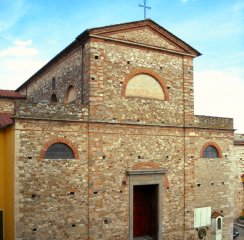
Parrocchia
Santi Pietro apostolo e Marco evangelista
Pieve a Nievole
History
St. Peter "Prope Neure" Ancient Church
The current Sts. Peter Apostle and Mark Evangelist parish church is most likely
superimposed on the ancient plebs Santi Petri de Neure (cfr. Atti
Tavole Rotonde, vol. 1) mentioned for the first time in an old paper bearing
the date 21st May 700, kept in hard copy at Lucca Historical
Archive.
The ancient church is also cited in a later document dating February 716: it is
a report compiled in the very church intended to settle a dispute between the
bishops of Lucca and Pistoia about administrative borders: the latter gave formal
undertaking in the presence of King Liutprando's heralds that he would that he
would acknowledge that the church would be under Lucca's sphere of influence.
No traces remain in existence of this earlier building, presumably made
out of wood, it is however probable that some archaeological evidence is
still lying within the current church's perimeter. Nevertheless, due
to a shallow depth soil, we are afraid that the 12th and 19th
century constructions may have deleted what was left.
Nothing do we know about what happened throughout the centuries, and as
far as chronological dating is concerned, the information we have is derived from
archaeological and architectural features.
Twelfth Century Rebuilding
We can state that the ancient St. Peter a Neure church had been increasing in
importance for centuries until it was completely rebuilt in the late
12th century: the renovation work fell within a wider modernisation
process addressed to all the churches in the Lucca district. The 12th
century church floor plan can be recreated through both the 1820s Leopold-era
Land Registry and the 1997-1998 archaeological excavations (cfr. Atti Tavole
Rotonde, vol.3).
The building was extended so far as to become one of the largest churches
throughout the Lucca territory. A quite impressive-sized bell tower was added to
the historical complex (the current bell tower restored in 2008 was build on the
still today unbroken original base), accommodations and service spaces were
enlarged (part of the previous fortified building is still in elevation but it
has now become part of private buildings next to the bell tower [cfr. Tavole
Rotonde, vol. 2, p. 4]). Massive foundations' archaeological remains account for
a defensive wall surrounding the ecclesiastical compound, including the dwelling
and the courtyard designated for the tithe collection.
A twenty-six Venetian silver coins "nest egg" together with a small
molten-lead cross, definitely a devotional artefact, can be both ascribed to the
ancient Pieve a Nuere's heyday: the latter is a typical pilgrim object found in
the church burial site, dated towards the end of 11th century and
currently kept in the parish. The coins are preserved at Larciano Museum.
Fourteenth and Fifteenth Centuries Decadence
Sequences of political unrest, wars and devastating epidemics caused St. Peter a
Neure church's unceasingly relentless downfall (cfr. Atti Tavole Rotonde, vol. 2, p. 33).
People and clergy had sought shelter and escaped to the fortified hamlet of
Montecatini, leaving the potentially dangerous and unhealthy swamps.
The past glorious church, whose priest-in-charge had already moved
elsewhere, was neglected but it still kept on serving the poorest people from
the countryside who could not afford to leave the area, in spite of the imminent
threats. During the 1430 pastoral visit, the church was in a serious state of
disrepair: the furnishings had completely deteriorated and the baptismal font was
found smashed into pieces and therefore impossible to use.
The Renaissance
Archaeological traces show that operations were probably resumed starting
from the 16th century, even if the site's return to life is due
to the impressive population growth that will take place only from the following
century onwards (cfr. Atti Tavole Rotonde, vol. 4).
The church was under extremely poor conditions and its "in cornu evangeli" side
aisle (the one on the left side entering) had collapsed. The arches underwent a
just-enough quick fix in order to make the whole building usable. In the
meantime, the bright and large brand new Corpus Domini Company's Chapel had
been finished in 1700. The chapel was built on people's request, probably
in order to meet their need: the previous and crumbling church was no longer
able to carry out its role as a proper place of worship. It had in fact lost
its parish-status and downgraded to a minor church, subjected to the Rectory
of St. Peter Apostle (already called St. Michael the Archangel), located in
the near-by hill of Montecatini.
Such a negligence situation had been going on for years up to 1820s,
when some of the Grand Duke's engineers ascertained that a renovation project
would have been unfeasible cause of the building's high deterioration rate.
This compelled them to the planning for a new church and the project
was undertaken by the Bernardinis, a very well-known craftsmen and architects
family (cfr. Atti Tavole Rotonde, vol. 1). Together with this church, finished
in 1846, they also were in charge of two other churches' construction: San
Leopoldo in Albinatico and Santa Maria della Neve in Chiesina Uzzanese. The
three buildings are very similar and characterised by a plain neoclassical style.
Since then there have been no historically relevant events and history has turned
into current affairs.
N.B. - All the references to Quaderni Pievarini and Atti
Tavole Rotonde can be downloaded from www.sanpietroaneure.it,
our historical studies centre website.
 Paintings
Paintings